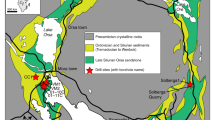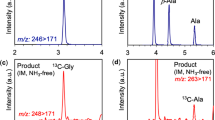Abstract
Meteorites can have played a role in the delivery of the building blocks of life to Earth only if organic compounds are able to survive the high pressures and temperatures of an impact event. Although experimental impact studies have reported the survival of organic compounds1,2,3,4,5,6, there are uncertainties in scaling experimental conditions to those of a meteorite impact on Earth1,2,3,4,5,6 and organic matter has not been found in highly shocked impact materials in a natural setting. Impact glass linked to the 1.2-km-diameter Darwin crater in western Tasmania7,8,9 is strewn over an area exceeding 400 km2 and is thought to have been ejected by a meteorite impact about 800 kyr ago into terrain consisting of rainforest and swamp7,10. Here we use pyrolysis–gas chromatography–mass spectrometry to show that biomarkers representative of plant species in the local ecosystem—including cellulose, lignin, aliphatic biopolymer and protein remnants—survived the Darwin impact. We find that inside the impact glass the organic components are trapped in porous carbon spheres. We propose that the organic material was captured within impact melt and preserved when the melt quenched to glass, preventing organic decomposition since the impact. We suggest that organic material can survive capture and transport in products of extreme impact processing, at least for a Darwin-sized impact event.
This is a preview of subscription content, access via your institution
Access options
Subscribe to this journal
Receive 12 print issues and online access
$259.00 per year
only $21.58 per issue
Buy this article
- Purchase on Springer Link
- Instant access to full article PDF
Prices may be subject to local taxes which are calculated during checkout



Similar content being viewed by others
References
Peterson, E., Horz, F. & Chang, S. Modification of amino acids at shock pressures of 3.5 to 32 GPa. Geochim. Cosmochim. Acta 61, 3937–3950 (1997).
Parnell, J. et al. The preservation of fossil biomarkers during impact: Experimental evidence from biomarker rich projectiles and target rocks. Meteorol. Planet. Sci. 45, 1340–1358 (2010).
Bowden, S. A. et al. The thermal alteration by pyrolysis of the organic component of small projectiles of mudrock during capture at hypervelocity. J. Anal. Appl. Pyrol. 82, 312–314 (2008).
Bowden, S. A. et al. Survival of organic compounds in ejecta from hypervelocity impacts on ice. Astrobiology 8, 19–25 (2009).
Fajardo-Cavazos, P. et al. Bacterial spores in granite survive hypervelocity launch by spallation: Implications for lithopanspermia. Astrobiology 97, 647–657 (2009).
Parnell, J. et al. Organic geochemistry of impactites from the Haughton impact structure, Devon Island, Nunavut, Canada. Geochim. Cosmochim. Acta 71, 1800–1819 (2007).
Howard, K. T. Physical distribution trends in Darwin glass. Meteorol. Planet. Sci. 44, 115–129 (2009).
Howard, K. T. Geochemistry of Darwin glass and target rocks from Darwin Crater, Tasmania, Australia. Meteorol. Planet. Sci. 43, 473–496 (2008).
Howard, K. T. & Haines, P. W. Geology of Darwin Crater. Earth Planet. Sci. Lett. 260, 328–339 (2007).
Loh, C. H et al. Laser fusion argon-40/argon-39 ages of Darwin Impact glass. Meteorol. Planet. Sci. 37, 1555–1562.
Melosh, H. J. The rocky road to panspermia. Nature 332, 687–688 (1988).
Melosh, H. J. Impact Cratering A Geologic Process (Oxford Univ. Press, 1989).
Koeberl, C. Geochemistry of tektites and impact glasses. Annu. Rev. Earth Planet. Sci. 14, 323–350 (1986).
Anders, E. Pre-biotic organic matter from comets and asteroids. Nature 342, 255–257 (1989).
Jenniskens, P. et al. Meteors: A delivery mechanism of organic matter to the early earth. Earth Moon Planets 82–83, 57–70 (2000).
Parnell, J. et al. Preservation of organic matter in the STONE 6 artificial meteorite experiment. Icarus 212, 390–402 (2011).
French, B. M. Traces of catastrophe a handbook of shock-metamorphic effects in terrestrial meteorite impact structures. LPI Contribution No 954 (Lunar and Planetary Institute, 1998).
Zak, K., Skala, R., Randa, A. & Mizera, J. A review of volatile compounds in tektites, and carbon content and isotopic composition of moldavite tektites. Meteorol. Planet. Sci. 47, 1010–1028 (2012).
Howard, K. T. Volatile enhanced dispersal of high-velocity impact melt and the origin of tektites. Proc. Geol. Assoc. 122, 363–382 (2011).
Artemieva, N. Tektites: model versus reality. LPS 39 abstract#1526 (2008).
Bailey, M. J, Howard, K. T., Kirkby, K. J. & Jeynes, C. Characterisation of inhomogeneous inclusions in Darwin glass using ion beam analysis. Nucl. Instrum. Methods B 267, 2219–2214 (2009).
Ralph, J. & Hatfield, R. D. Pyrolysis-GC-MS characterization of forage materials. J. Agricul. Food Chem. 39, 1426–1437 (1991).
Koeberl, C., Poag, C. W., Reimold, W. U. & Brandt, D. Impact origin of the Chesapeake Bay structure and the source of the North American tektites. Science 271, 1263–1266 (1996).
Stoffler, D., Artemieva, N. A. & Pierazzo, E. Modelling the Ries-Steinham impact event and the formation of the Moldavite Strewn Field. Meteorol. Planet. Sci. 37, 1893–1970 (2002).
Bland, P. The impact rate on Earth. Phil. Trans. R. Soc. 363, 2793–2810 (2005).
Armstrong, J. C., Wells, L. E. & Gonzalez, G. Rummaging through Earth’s attic for remains of ancient life. Icarus 160, 183–196 (2002).
Mileikowsky, C. et al. Natural transfer of viable microbes in space. Icarus 145, 391–427 (2000).
Gladman, B. et al. Impact seeding and reseeding in the inner Solar System. Astrobiology 5, 483–496 (2005).
Bland, P. A. & Smith, T. B. Meteorite accumulations on Mars. Icarus 144, 21–26 (2000).
Acknowledgements
This work was supported by STFC through the UK Cosmochemistry Analysis Network (UK-CAN) at The Natural History Museum. The Engineering and Physical Sciences Research Council (EPSRC) provided access to beam time at Surrey Ion Beam Centre. Z.M. acknowledges financial support by the Royal Society. Sample collection was supported by: University of Tasmania, Department of Primary Industry Water and Environment (Tas.) and Barringer Crater Company. Tasmanian Aboriginals are the traditional owners of Darwin glass and Darwin crater.
Author information
Authors and Affiliations
Contributions
K.T.H. discovered the inclusions, planned the project and wrote the manuscript with P.A.B., who also helped interpret data. M.J.B. and C.J. collected and interpreted ion beam data. R.M., Z.M. and M.S. collected and interpreted organic matter data. D.B. and V.S. carried out TEM analyses. L.E.H. collected XuM images. S.V. collected and interpreted carbon isotope data. G.C. carried out XRD analyses and helped interpret data.
Corresponding author
Ethics declarations
Competing interests
The authors declare no competing financial interests.
Supplementary information
Supplementary Information
Supplementary Information (PDF 2863 kb)
Supplementary movie 1
Supplementary movie 1 (MOV 1125 kb)
Rights and permissions
About this article
Cite this article
Howard, K., Bailey, M., Berhanu, D. et al. Biomass preservation in impact melt ejecta. Nature Geosci 6, 1018–1022 (2013). https://doi.org/10.1038/ngeo1996
Received:
Accepted:
Published:
Issue Date:
DOI: https://doi.org/10.1038/ngeo1996
This article is cited by
-
Evidence of Cosmic Impact at Abu Hureyra, Syria at the Younger Dryas Onset (~12.8 ka): High-temperature melting at >2200 °C
Scientific Reports (2020)
-
Analytical methodology to evaluate the Terrestrial Weathering of Libyan Desert Glasses and Darwin Glasses after their formation
Analytical and Bioanalytical Chemistry (2019)
-
Detection of organic compounds in impact glasses formed by the collision of an extraterrestrial material with the Libyan Desert (Africa) and Tasmania (Australia)
Analytical and Bioanalytical Chemistry (2018)



